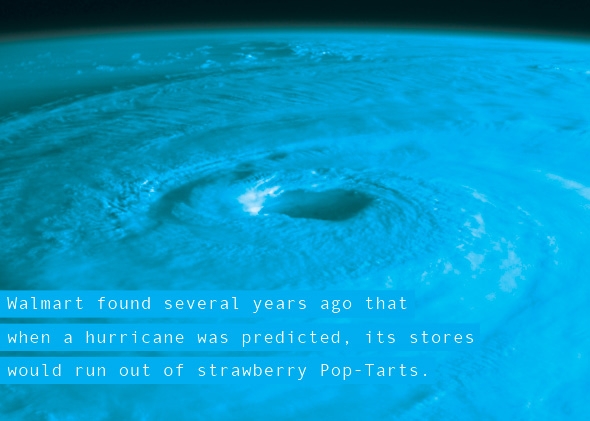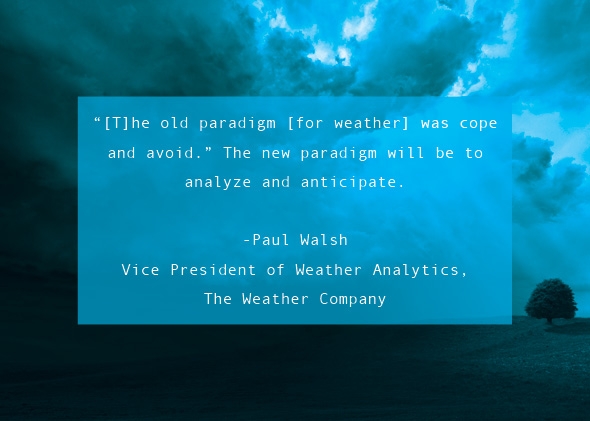
What the Weather Has in Stores
Retailers have embraced big data to get a better handle on what their customers want. Now they're adding highly detailed weather information to the mix.

The minute rain begins in New York City, street vendors pop up to sell cheap umbrellas.
“Umbrella salesmen are a gross example of weather-driven demand,” said Paul Walsh, vice president of weather analytics at The Weather Company.
Americans collectively plan their lives based in large measure on what is happening outside, and weather has a significant impact on people’s moods. For both reasons, Walsh said, atmospheric conditions are enormously influential on buying decisions.
So it's no surprise that The Weather Company and IBM are coming together to build a far more sophisticated way to investigate the impact of local weather on sales.
Hurricane Pop-Tarts and Beyond
Here's a truth in retail: Get the weather right and plan your inventory accordingly, and you will profit.
But retailers must have an understanding of the weather-retail dynamic that goes beyond knowing that snow shovels won’t sell on a 60-degree March day. Walmart found several years ago that when a hurricane was predicted, its stores would run out of strawberry Pop-Tarts. Why? The snacks don’t need to be refrigerated and have a long shelf life, so they come in handy during power outages, which often follow hurricanes.
Predicting those less obvious connections between weather and sales is the goal of the partnership of The Weather Company and IBM.
The Weather Company is a marvel of big data. Its staff of 200 meteorologists continuously collects real-time data from tens of thousands of weather sensors positioned at different strata in the atmosphere, and compares it to historical data to provide increasingly granular forecasts with a great deal of clarity and accuracy. IBM, through data analytics offerings such as Watson Analytics and BlueMix, allows retailers to collect, collate, and analyze minutely detailed data on sales — by region, by product, by time of day, across hundreds of stores. Combine those two collections of information, and you have some serious prediction power.
“The more data, the more precise your predictions,” said Erick Brethenoux, head of business analytics strategy at IBM.

Goodbye to Gut Instincts
In March, the companies announced a partnership in which IBM will offer The Weather Company’s data to clients, and help them layer the information on top of historical retail data and sentiment. Additionally, the two entities will work together on new products and services to serve weather-affected industries including insurance, retail and government.
The result could be a transformation of the traditionally fatalistic attitude that businesses had toward the weather.
“People always knew that weather affected them, but they saw it as something they couldn’t control,” said Walsh, who has been working with retailers for more than 20 years. “So the old paradigm was cope and avoid.”
The new paradigm, Walsh said, will be to analyze and anticipate.
To a degree, that will upend some practices in retail, an industry in which instincts about what will sell can make or break a company. “Our guts are useful,” said Bretheroux. “But very often the data is challenging these sorts of assumptions.”

Forecast Buying Behavior
IBM has been working on a prototype effort with a coffee company whose expensive downtown locations leave it with little wiggle room for holding excess inventory. The weather has a huge impact on the types of products it will need — and be able to sell — on a daily basis.
Yes, the weather helps decide whether people buy iced coffee or steaming cups of lattes. But weather conditions also affect the pairing of pastries with drinks — people will dunk a donut in hot coffee, but not in an iced cappuccino. Behavior varies, too, based on the time of day (i.e., whether it is cold in the morning versus at night) and even on the day of the week.
“People don’t feel the same about rain on a Friday as they do when it rains on Monday,” said Bretheroux.
The difference between the number of croissants a store might sell on a sunny Monday or a rainy Friday could be significant. Armed with analytics, the chain is starting to match weather data with past buying behavior to help it predict and manage demand based on short-term forecasts.
Another client, a large superstore in Europe, uses weather data to decide which of the tens of thousands of goods it offers to display at the end of its aisles. Having a clearer grasp on the weather forecast also helps the store position resources for its new takeout service, in which customers order online but then drive in to pick up the goods. It turns out customers are more likely to use the service when it is colder.
Location, Location, Location
People are making more weather-based decisions thanks in part to the proliferation of smartphones and apps. When the weather forecast is literally at your fingertips, you consume more weather information. That puts more pressure on retailers, but also provides an opportunity.
Weather, like politics, is local. And so is the reaction to it. An inch of snow in Atlanta has far different implications for spending than an inch of snow in Minneapolis. And as the Wall Street Journal reported, The Weather Company found that sales of insect repellent rise in Dallas when the dew point is below average, while sales of the same products in Boston do better when the dew point is higher than average.
IBM and the Weather Company are arming retailers with highly accurate hyper-local forecasts. “We can look at a square kilometer and predict the weather for that location,” said Walsh. They also are giving retailers insights on correlated buying behavior, which allows stores and marketers to position their inventory and serve mobile ads and offerings to people at the right time.
“The weather isn’t always good every day,” said Walsh. “But it’s always good for something every day.”
